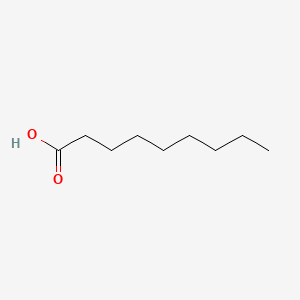| MeSH term | MeSH ID | Detail |
|---|---|---|
| Dermatitis, Contact | D003877 | 59 associated lipids |
| Facial Dermatoses | D005148 | 7 associated lipids |
| Hypersensitivity | D006967 | 22 associated lipids |
| Arteriosclerosis | D001161 | 86 associated lipids |
| Seizures | D012640 | 87 associated lipids |
| Dermatitis, Allergic Contact | D017449 | 20 associated lipids |
| Riboflavin Deficiency | D012257 | 10 associated lipids |
| Lichen Planus | D008010 | 3 associated lipids |
| Keratosis | D007642 | 9 associated lipids |
| Tick Infestations | D013984 | 4 associated lipids |
NONANOIC ACID
NONANOIC ACID is a lipid of Fatty Acyls (FA) class. Nonanoic acid is associated with abnormalities such as megalocytosis, Hypos, Renal tubular disorder, Respiratory Distress Syndrome, Adult and Little's Disease. The involved functions are known as Gene Expression, Signal Transduction, Regulation, Cell Cycle and Force. Nonanoic acid often locates in Membrane, Protoplasm, Body tissue, Extracellular and Cell membrane. The associated genes with NONANOIC ACID are cysteinylglycine, glycylsarcosine, arginine methyl ester, GLI3 gene and ADRBK1 gene. The related lipids are 1-octen-3-ol, Butyric Acids, palmitoleic acid, pentadecanoic acid and stearic acid.
Cross Reference
Introduction
To understand associated biological information of NONANOIC ACID, we collected biological information of abnormalities, associated pathways, cellular/molecular locations, biological functions, related genes/proteins, lipids and common seen animal/experimental models with organized paragraphs from literatures.
What diseases are associated with NONANOIC ACID?
NONANOIC ACID is suspected in megalocytosis, Hypos, Renal tubular disorder, Respiratory Distress Syndrome, Adult, Little's Disease and other diseases in descending order of the highest number of associated sentences.
Related references are mostly published in these journals:
- Am. J. Physiol. Heart Circ. Physiol. (1)
- Am. J. Physiol. Lung Cell Mol. Physiol. (1)
- Am. J. Physiol. Renal Physiol. (1)
- Others (1)
| Disease | Cross reference | Weighted score | Related literature |
|---|
Possible diseases from mapped MeSH terms on references
We collected disease MeSH terms mapped to the references associated with NONANOIC ACID
PubChem Associated disorders and diseases
What pathways are associated with NONANOIC ACID
There are no associated biomedical information in the current reference collection.
PubChem Biomolecular Interactions and Pathways
Link to PubChem Biomolecular Interactions and PathwaysWhat cellular locations are associated with NONANOIC ACID?
Visualization in cellular structure
Associated locations are in red color. Not associated locations are in black.
Related references are published most in these journals:
- Am. J. Physiol. Heart Circ. Physiol. (4)
- Am. J. Physiol. Lung Cell Mol. Physiol. (1)
- Am. J. Physiol., Cell Physiol. (1)
- Others (6)
| Location | Cross reference | Weighted score | Related literatures |
|---|
What functions are associated with NONANOIC ACID?
Related references are published most in these journals:
| Function | Cross reference | Weighted score | Related literatures |
|---|
What lipids are associated with NONANOIC ACID?
Related references are published most in these journals:
| Lipid concept | Cross reference | Weighted score | Related literatures |
|---|
What genes are associated with NONANOIC ACID?
Related references are published most in these journals:
- Am. J. Physiol. Heart Circ. Physiol. (2)
- Acta Trop. (1)
- Am. J. Physiol. Lung Cell Mol. Physiol. (1)
- Others (3)
| Gene | Cross reference | Weighted score | Related literatures |
|---|
What common seen animal models are associated with NONANOIC ACID?
There are no associated biomedical information in the current reference collection.
NCBI Entrez Crosslinks
All references with NONANOIC ACID
Download all related citations| Authors | Title | Published | Journal | PubMed Link |
|---|---|---|---|---|
| Benning UF et al. | New aspects of Phloem-mediated long-distance lipid signaling in plants. | 2012 | Front Plant Sci | pmid:22639651 |
| Poblete-Castro I et al. | The metabolic response of P. putida KT2442 producing high levels of polyhydroxyalkanoate under single- and multiple-nutrient-limited growth: highlights from a multi-level omics approach. | 2012 | Microb. Cell Fact. | pmid:22433058 |
| Tetrick MA et al. | Octanoate and nonaoate oxidation increases 50-80% over the first two days of life in piglet triceps brachii and gracilis muscle strips. | 2012 | J. Nutr. | pmid:22513984 |
| Jiang X et al. | Biosynthesis and properties of medium-chain-length polyhydroxyalkanoates with enriched content of the dominant monomer. | 2012 | Biomacromolecules | pmid:22871146 |
| Piotrowska-Tomala KK et al. | Lipopolysaccharides, cytokines, and nitric oxide affect secretion of prostaglandins and leukotrienes by bovine mammary gland epithelial cells. | 2012 | Domest. Anim. Endocrinol. | pmid:22608768 |
| Toubiana D et al. | Metabolic profiling of a mapping population exposes new insights in the regulation of seed metabolism and seed, fruit, and plant relations. | 2012 | PLoS Genet. | pmid:22479206 |
| Gunasekara DB et al. | Microchip electrophoresis with amperometric detection for the study of the generation of nitric oxide by NONOate salts. | 2012 | Anal Bioanal Chem | pmid:22415023 |
| Kasam M et al. | Nitric oxide facilitates delivery and mediates improved outcome of autologous bone marrow mononuclear cells in a rodent stroke model. | 2012 | PLoS ONE | pmid:22412926 |
| Mehta DR et al. | The nitric oxide pathway provides innate antiviral protection in conjunction with the type I interferon pathway in fibroblasts. | 2012 | PLoS ONE | pmid:22363706 |
| Kumar A et al. | MetRxn: a knowledgebase of metabolites and reactions spanning metabolic models and databases. | 2012 | BMC Bioinformatics | pmid:22233419 |
